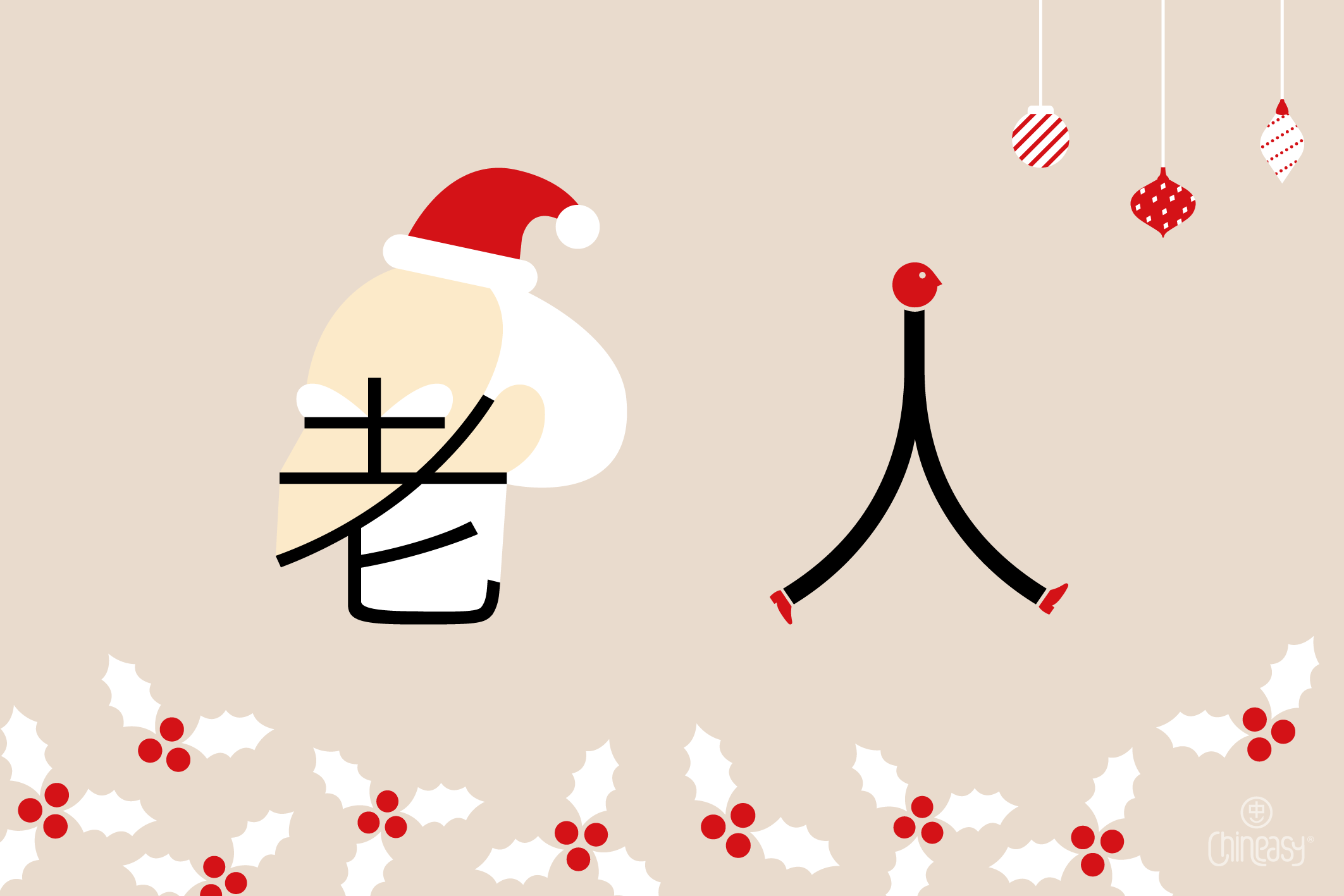Is autumn your favorite season? The temperature starts to drop, and on a brisk day, there’s nothing better than enjoying the refreshing air while strolling in the park. These cool but sunny days are a delightful time of the year, full of vibrant colors and cozy moments.
In this blog post, we’ve got a list of the top 10 Chinese words all about autumn. Ready to give your language skills a big boost? Let’s use your Mandarin vocabulary to capture the essence of autumn.
Autumn/Fall 秋天
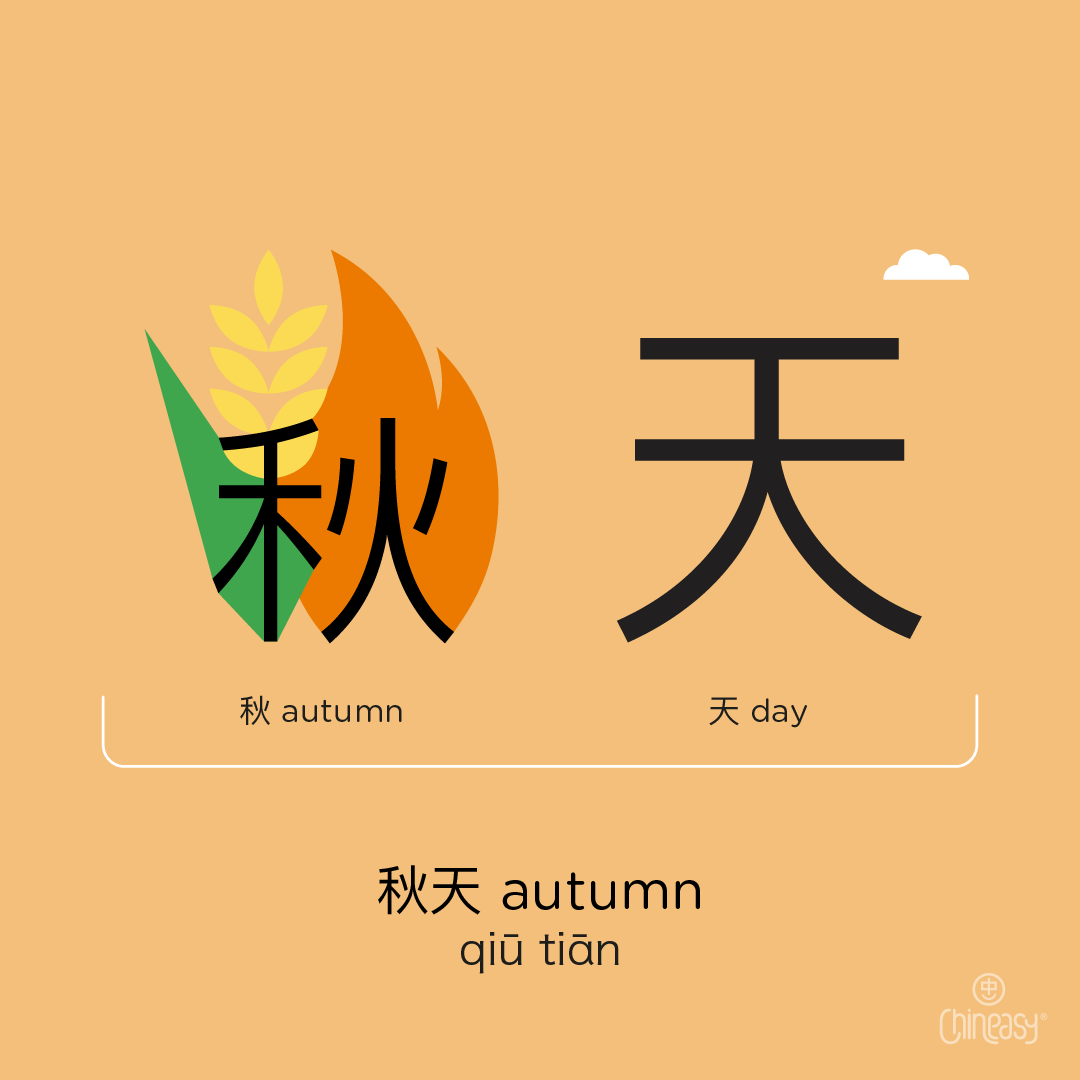
Autumn in Chinese is 秋天 (qiū tiān), where 秋 (qiū) means “autumn” and 天 (tiān) means “day” or “sky.” The character 秋 is made up of 禾 (hé), meaning “grain,” and 火 (huǒ), meaning “fire.”
This reflects the traditional practice of burning fields after the harvest to prepare for the next planting season.
Autumn is a time of harvest and preparation, making it a season of both closure and anticipation.
Example sentence:
Autumn is the season of harvest.
秋天是收穫的季節。(in traditional Chinese)
秋天是收获的季节。(in simplified Chinese)
Pinyin: qiūtiān shì shōuhuò de jìjié
Literally: autumn + is + harvest + of + season
Maple Tree 楓樹/枫树
The sight of maple trees with their vibrant red leaves is one of the most iconic images of autumn. In Chinese, 楓樹/枫树 (fēng shù) is the term for “maple tree,” where 楓/枫 (fēng) means “maple” and 樹 (shù) means “tree.”
To talk about “maple leaf,” you say 楓葉/枫叶 (fēng yè). 葉/叶 (yè) means “leaf.”
Maple leaves are often associated with poetry and art in Chinese culture, symbolizing beauty and the passage of time.
Example sentence:
Maple trees are so beautiful.
楓樹太美了。
枫树太美了。
Pinyin: fēngshù tài měi le
Literally: maple + tree + so + beautiful + the grammatical particle 了
Windy 多風/多风
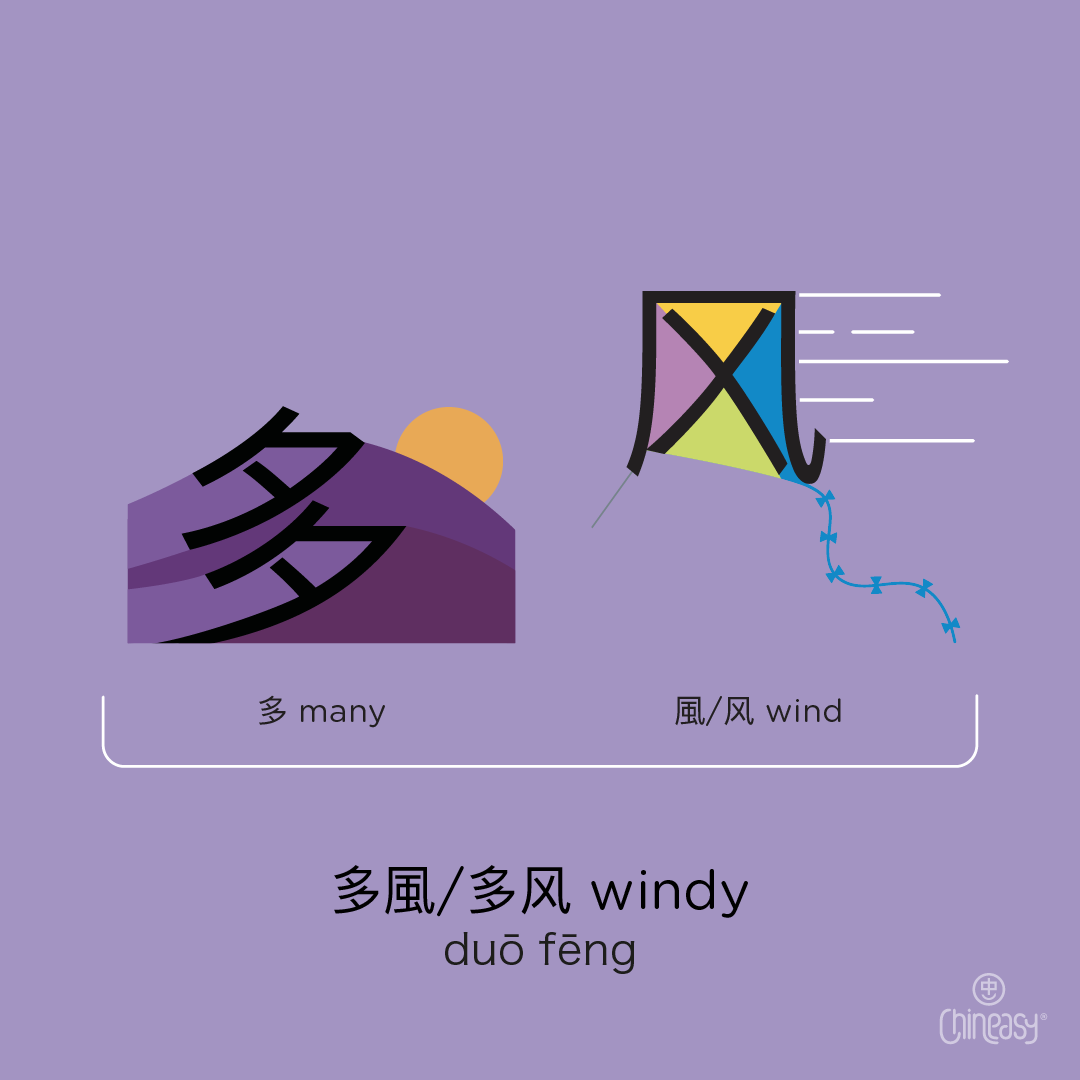
Autumn winds bring a refreshing chill and a sense of change in the air. The phrase 多風/多风 (duō fēng) literally translates to “many winds,” describing those breezy days when the leaves dance in the wind.
Autumn tends to be windier due to the temperature difference between the cooling land and the still-warm oceans, creating more air movement. This shift in temperature makes windy days a hallmark of the season.
Example sentence:
It’s windy today, so refreshing.
今天多風,真涼爽。
今天多风,真凉爽。
Pinyin: jīntiān duōfēng, zhēn liángshuǎng
Literally: today + windy + really + refreshing
Fallen leaves 落葉/落叶
One of the most beautiful signs of autumn is the fallen leaves. In Chinese, 落葉/落叶 (luò yè) combines 落 (luò), meaning “to fall,” and 葉/叶 (yè), meaning “leaf.” As temperatures drop, trees shed their leaves to conserve energy for winter. Watching leaves gently fall to the ground is a quintessential autumn experience.
Example sentence:
There are fallen leaves everywhere.
到處都是落葉。
到处都是落叶。
Pinyin: dàochù dōu shì luòyè
Literally: everywhere + all + is/are + fallen leaves.
Cold 冷
As autumn progresses, the air becomes noticeably colder. The character 冷 (lěng) is straightforward, meaning “cold.” The shift from warm to cold weather in autumn is often seen as a time to start preparing for the coming harsher winter months.
Example sentence:
Autumn is colder than spring.
秋天比春天冷。
秋天比春天冷。
Pinyin: qiūtiān bǐ chūntiān lěng
Literally: autumn + compare + spring + cold.
Sweater/jumper 毛衣
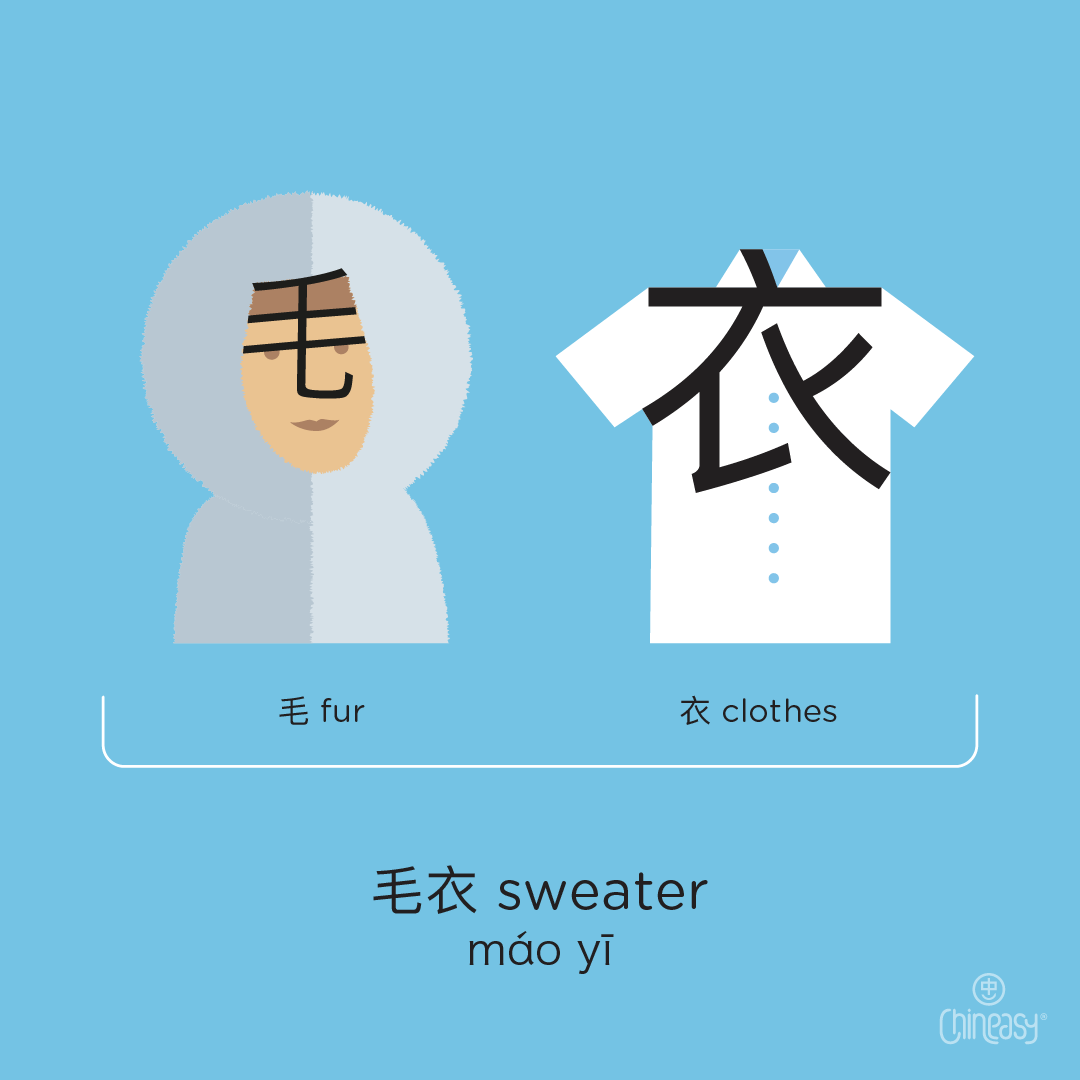
With the cooler weather comes the need for warmer clothing. 毛衣 (máo yī), meaning “sweater,” combines 毛 (máo) meaning “fur” and 衣 (yī) meaning “clothing.” Sweaters are a quintessential part of autumn attire, keeping you cozy as the temperature drops.
Example sentence:
This is my new sweater.
這是我的新毛衣。
这是我的新毛衣。
Pinyin: zhè shì wǒde xīn máoyī
Literally: this + is + my + new + sweater
Chestnut 栗子
Chestnuts roasting on an open fire are a classic autumn treat. 栗子 (lì zi), the Chinese word for chestnut, consists of two characters: 栗 means “chestnut,” and 子 is a noun suffix in this context.
Chestnuts are a popular autumn snack in China, especially roasted chestnuts known as 炒栗子 (chǎo lì zi). Often sold as street food, they fill the air with a sweet, toasty aroma.
China has over 300 varieties of chestnuts! Smaller, sweeter chestnuts are ideal for roasting, while larger ones are used more in cooking.
Example sentence:
I like eating roasted chestnuts.
我喜歡吃炒栗子。
我喜欢吃炒栗子。
Pinyin: wǒ xǐhuān chī chǎo lìzi
Literally: I + like + eat + to saute + chestnut.
Pumpkin 南瓜
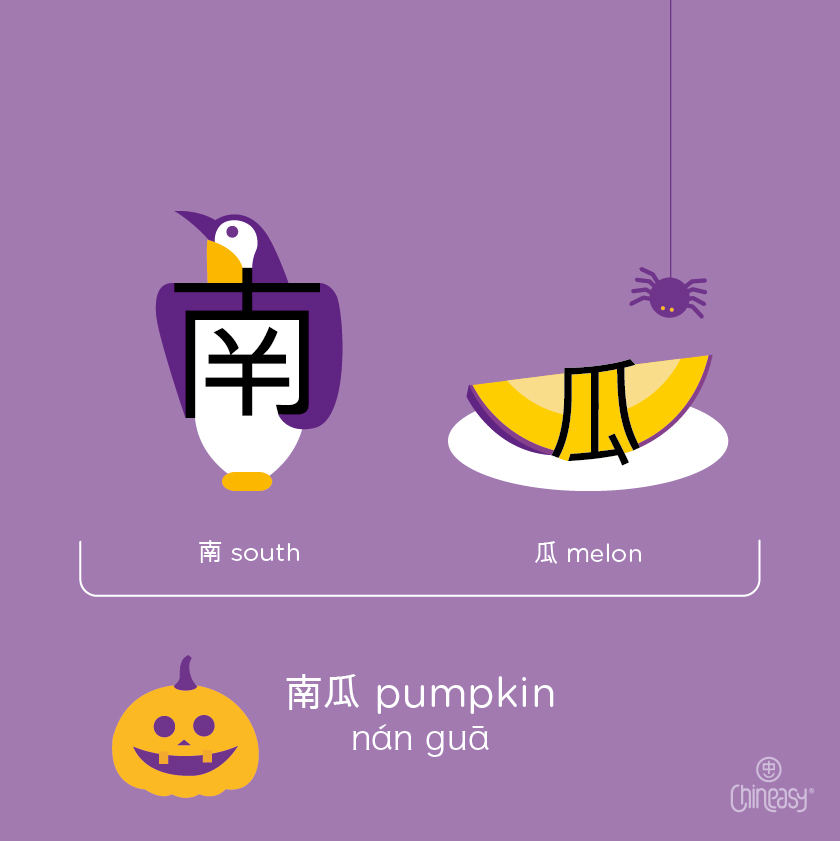
Pumpkins are synonymous with autumn, from harvest festivals to Halloween decorations. The Chinese term for pumpkin is 南瓜 (nán guā), where 南 (nán) means “south” and 瓜 (guā) means “melon.”
Pumpkins grow best in southern China, which is why they’re referred to as “south melon.”
Example sentence:
Pumpkin is delicious.
南瓜很好吃。
南瓜很好吃。
Pinyin: nánguā hěn hǎochī
Literally: pumpkin + the grammatical particle 很 + tasty.
Halloween 萬聖節/万圣节
Halloween is a time for costumes and spooky fun. In Chinese, 萬聖節/万圣节 (wàn shèng jié) translates to “All Saints’ Day.” While it’s not traditionally a Chinese holiday, it has become increasingly popular, especially among younger generations.
Example sentence:
Halloween is coming.
萬聖節快到了。
万圣节快到了。
Pinyin: wànshèngjié kuài dàole.
Literally: Halloween + soon + arrive + + the grammatical particle 了
Thanksgiving 感恩節/感恩节
Thanksgiving, known as 感恩節/感恩节 (gǎn ēn jié) in Chinese, is a time for expressing gratitude and enjoying a bountiful meal with family and friends. Although it’s not traditionally celebrated in China, the concept of giving thanks and gathering with loved ones resonates with the Chinese cultural values of family and togetherness.
Example sentence:
Thanksgiving is coming.
感恩節快到了。
感恩节快到了。
Pinyin: gǎnēnjié kuài dào le.
Literally: Thanksgiving + soon + arrive + + the grammatical particle 了
Here you have it – the top 10 Chinese words for 秋天. Bundle up in your cozy 毛衣 as the air gets 冷, and enjoy a breezy walk through the 多風/多风 park surrounded by 楓樹/枫树 and 落葉/落叶. Afterwards, head home to cook a dish with 南瓜 or 栗子. And don’t forget to check your calendar for 萬聖節/万圣节 and 感恩節/感恩节 plans. Let’s be grateful for all the wonderful gifts that Mother Nature provides this season.

